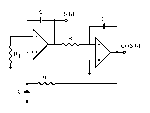johnson933
Newbie level 3
Hi all,
i have read the post about reply quadrature oscillator design(early posted by 17-05-08 , do a search about quadrature oscillator design at right top corner can get it).
and i am now able to generate out both sine and cosine wave already.
but, i think there is a formular which state f = 1/2pi RC.
may i know that if i wants a frequency 1MHz output,
and i assume that C = 0.047uF, i found that R = 3.3kΩ.(closest standard value)
is the calculation correct?
(btw i want to get both sine and cosine wave same amplitue.)
hence i connect the circuit like state in

however i only can get a output frequency like 13+MHz,
and the Vp-p is about 100mV.
how can i do to make the output Frequency 1MHz and Vp-p like 3-4.5V?
apreciate if anyone can help.
Best Regards,
Johnson933
i have read the post about reply quadrature oscillator design(early posted by 17-05-08 , do a search about quadrature oscillator design at right top corner can get it).
and i am now able to generate out both sine and cosine wave already.
but, i think there is a formular which state f = 1/2pi RC.
may i know that if i wants a frequency 1MHz output,
and i assume that C = 0.047uF, i found that R = 3.3kΩ.(closest standard value)
is the calculation correct?
(btw i want to get both sine and cosine wave same amplitue.)
hence i connect the circuit like state in

however i only can get a output frequency like 13+MHz,
and the Vp-p is about 100mV.
how can i do to make the output Frequency 1MHz and Vp-p like 3-4.5V?
apreciate if anyone can help.
Best Regards,
Johnson933